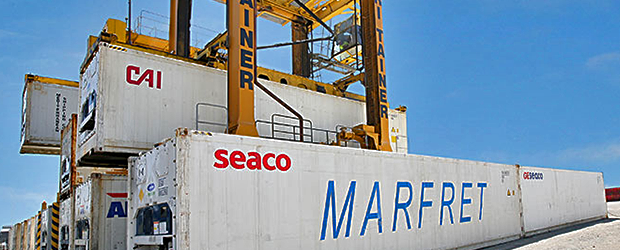
The word reefer, in this context, is a snappy interpretation of the multi-syllable term, refrigeration. The word sits on the tongue and shipping manifests a touch easier than the longer root label that the condensed term is derived from, maybe causing confusion to the layperson, but essential functionality is clear. Reefer containers are simply engineered refrigeration boxes that are equally comfortable in a storage or transportation scenario.
If thinking of a reefer as a huge reinforced domestic refrigerator makes the container easier to understand, stick with this image, but in truth these massive units are a great deal more. Each container is a stand-alone storage unit designed to provide a carefully maintained environment for a perishable cargo. The onboard cooling system adopts a programmable interface to keep this cooling free of transient errors during transit changes, for example the transferal of the unit from a ship to an international port, or the rough passage along a highway on the back of an eighteen-wheeler truck. Returning to ship-operated reefers, these units typically follow the endorsed cargo container dimensions, a measurement that takes multiples of twenty foot lengths to create the TEU standardized capacity scale, an acronym that translates to Twenty-foot Equivalent Lengths.
Aside from the logistical inception of the TEU unit of capacity, reefers also adopt the reinforced steel exterior associated with standard containers. Thus both forms of containers look much alike and they obey the ISO standardization codes for transportation and storage. The key difference is in the outfitting of an electrical assembly at one end of the container. This electrical hook-up can be routed to the electrical supply of a ship, normally a 440-Volt alternating current power supply, or be obtained from the stand-alone diesel generator mounted on the reefer. One common alternative to the diesel operational model is the supply of standard electrical power from a storage depot. Imagine a rental facility with digital readout panels managing the interior climate-control of the insulated container and you have the beginnings of a powerful solution for the storage of meat, vegetables, pharmaceutical products, and other perishable products at a cost that's a fraction of what's offered by the diesel alternative. Of course, the fuel version is the more efficient and perhaps only answer to transporting reefers along highways and rail tracks.
Capable of keeping the interior of an insulated container frosty, below -13F, reefers are part of the international freight transportation intermodal system, but there's a final application potential customers should be aware of here. Pushing the transportation sequence of events to the side for a moment, reefers also make excellent storage containers for overflow, for commercial warehouses and cramped walk-in coolers, delivering all the space a temperature-dependent operation could ever need.
| After Hours: | Danny 0408 488 114 |
Optimized by NetwizardSEO.com.au